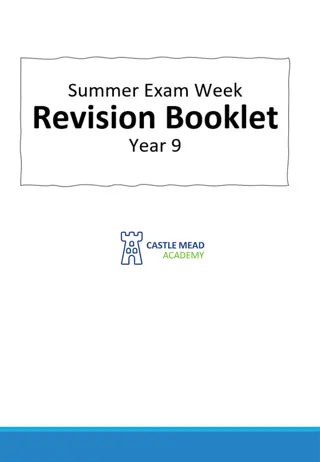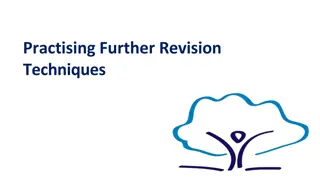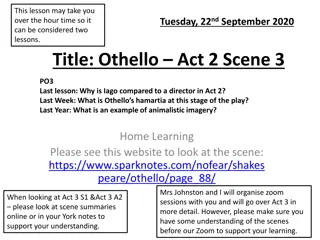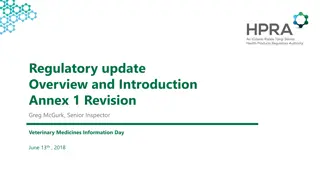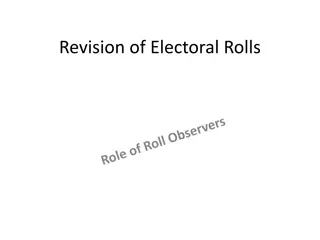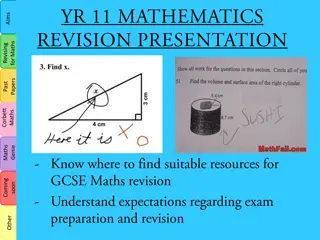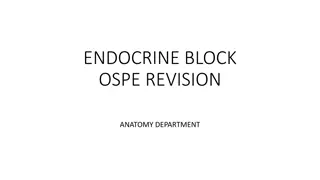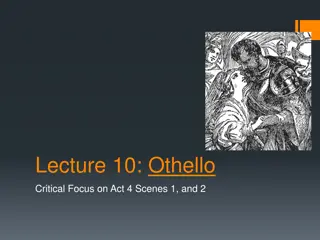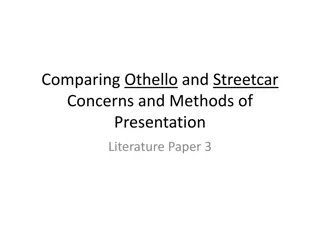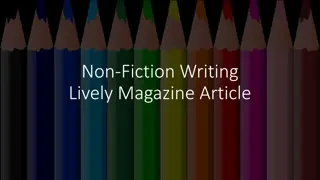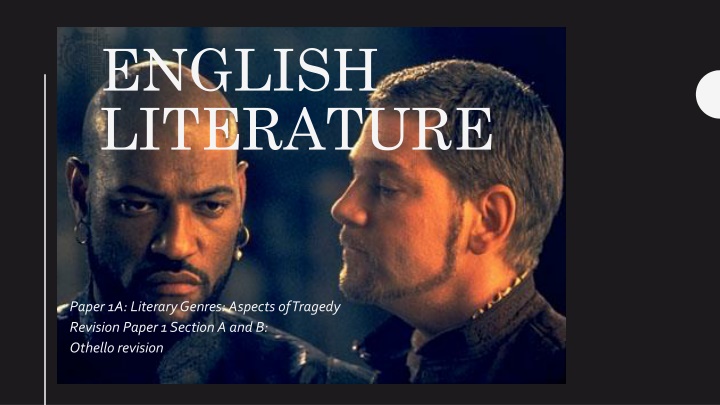
Exploring Tragic Elements in Othello: Analysis & Revision Guide
Delve into the aspects of tragedy in Othello with this comprehensive revision guide, analyzing key characters, settings, and dramatic elements. Explore the tragic hero, victims, and villains, as well as themes of fate, recognition, and social bonds. Enhance your understanding of Shakespeare's dramatic methods and prepare for detailed exam essays on Othello's tragic path.
Download Presentation

Please find below an Image/Link to download the presentation.
The content on the website is provided AS IS for your information and personal use only. It may not be sold, licensed, or shared on other websites without obtaining consent from the author. If you encounter any issues during the download, it is possible that the publisher has removed the file from their server.
You are allowed to download the files provided on this website for personal or commercial use, subject to the condition that they are used lawfully. All files are the property of their respective owners.
The content on the website is provided AS IS for your information and personal use only. It may not be sold, licensed, or shared on other websites without obtaining consent from the author.
E N D
Presentation Transcript
ENGLISH LITERATURE Paper 1A: Literary Genres: Aspects of Tragedy Revision Paper 1 Section A and B: Othello revision
Assessment overview SECTION A EXAM ESSAY FORMAT: Explore the significance of aspects of dramatic tragedy in the following passage in relation to the play as a whole. You should consider the following in your answer: The presentation of the characters The dramatic setting Other relevant aspects of dramatic tragedy Other quotes from the play [25 marks]
Assessment overview SECTION B EXAM ESSAY FORMAT You will have a choice of two questions. There will be statements that involve debating a point of view. The question will always ask To what extent do you agree with this view? You must write about Shakespeare s dramatic methods. 50 of the 75 marks available are on Othello. You need to know Othello very well!! If you have not read the play again, you need to do this.
Aspects of tragedy starter activity In groups mind map as many aspects of tragedy as you can. Particularly good groups may link these tragic features to Othello.
Tragic victims Inability to see the truth Moment of realisation Learning and moral growth settings misjudgements catastrophe Changes of fortune isolation Creation of fear and pity hubris Tragic hero Tragedy Blindness power Treatment of women Suffering Hostility of nature resolution Tragic flaws catharsis Flawed characters Positives emerging Loss death Tragic fall conflict
Aspects of tragedy A tragic hero A protagonist of high status Tragic victims and tragic villains A sudden reversal of fortune The presence of fate and how the hero s end can be seen as inevitable A moment of tragic recognition Shows the full horror of life How Shakespeare adds to the significance of certain events by the position of those events in the play s narrative; what characters know and don t know at specific times. Conventional social bonds are broken Raises fundamental questions about life Ambitious themes and subject matter Acts as a commentary on the real world and moves the audience to a greater understanding of the human condition
Othellos tragic path In the course of the play, Othello apparently changes from the noble Moor to a devil and a murderous coxcomb . In Act 1 Scene 2, he speaks with calm authority: Keep up your bright swords, for the dew will rust them (line 59). By the start of Act 4, he is suffering from tortured confusion: Pish! Noses, / ears, and lips. Is t possible? Confess? Handkerchief? O devil! (lines 40-1). Turn to page 226 in your copy of the play. In groups of five, each person takes one act of the play and researches Othello s role completing the activities on page 226. Present your ideas to the class.
Dramatic Structure starter activity Consider aspects of dramatic structure, what might you consider when writing about the structure of a drama text?
Dramatic structure Five-act Shakespearean plot includes: introduction, exposition, complication, crisis, resolution and denouement. The division of the play into acts and scenes The use of subplots Linearity, chronological events, analepsis, moments of crisis, pace and time. The opening and the ending of the play Conflict and change Setting Protagonist, antagonist and catalyst
Stagecraft starter activity You need to consider the play as intended for staged performance. What would you write about in terms of the staging of the play?
Stagecraft You must consider the text as incomplete in written form, a blueprint for a performance that needs to be seen in performance. Shakespeare gives some specific direction about aspects of stagecraft such as: Stage directions Sound Setting/time/light Disguise Act opening/ending Entrance/exit with opening and closing lines Dramatic irony Pace/tension/suspense/surprise Moments of comic relief
Dramatic speech and language Dialogue Soliloquy Asides Metaphorical, poetic, symbolic language Verse (pentameter) and prose Changes in the way a character uses language Shared lines
ACT 1 KEY QUOTES In pairs select 5 key quotes from Act 1 Feedback to the class
Othello Quotes Even now, now and very now, an old black ram is tupping your white ewe. Iago
Othello quotes Your daughter and the Moor are now making the beast with two backs. Iago
Othello quotes I am not what I am. Iago
Othello quotes My parts, my title and my perfect soul shall recommend me to him. Othello
Othello quotes She loved me for the dangers I had passed, and I loved her that she did pity them. Othello
Othello quotes But I do love thee, and when I love thee not, chaos is come again. Othello
Othello quotes He hath a daily beauty in his life, that makes me ugly. Iago
Othello quotes O beware my lord of jealously. It is the green- eyed monster that doth mock the meat it feeds on. Iago
Othello quotes Hell and night must bring this monstrous birth to the world s light. Iago
Othello quotes And out of her goodness make the net that shall enmesh them all. Iago
Context Elizabethan Patriarchal society, women seen as subordinate and inferior. Expected to be obedient in marriage. White Christian supremacy over inferior heathen races. Theatrical and literary representations of black Africans in Elizabethan times where generally negative. Racial stereotyping equating blackness with cannibalism, cruelty, animal sexuality and the devil. Othello however reverses this initial expectation as the noble Moor . Racial isolation and victimisation Othello is repeatedly de-humanised, de-personalised and degraded Iago s duplicitous manipulation could easily be judged as racially motivated. There were black Africans in London at the time, as a consequence of early Elizabethan slavery expeditions, there was a climate of fear and hatred towards them. Elizabeth made a Royal Proclamation authorising the deportation of infidels, having no understanding of Christ or his Gospel . Safe to say, there was growing hostility to towards marginalised black Africans in London. Shakespeare exploits a cultural opportunity to develop a more complex and sympathetic representation of the black experience for a predominantly white audience.
Themes and Imagery Themes jealousy, race and colour, man and woman Imagery Poisoning Hell and the devil in Animals and insects, including the idea of hunter and hunted, prey and predator and ideas of taming wild animals Othello Falconry Iago positions himself as the master falconer of the play in his manipulation of Othello, Desdemona, Cassio, Roderigo, Montano, Ludovico. Both Iago and Othello both refer to Desdemona as a hawk (patriarchal metaphor) The sea and military heroism Black and white, light and darkness ACTIVITY: Find quotes to illustrate these themes and examples of imagery, remember to write down the Act, Scene and line of the play.
Section A Suggested approach Play as a tragedy and Othello as a tragic hero Contextualise the extract Detailed close textual analysis of the extract, making links to context
Section B suggested approach Conventional essay structure Make frequent reference to the question and make sure you draw a conclusion Follow a clear line of argument This question has the same expectations as Section B Paper 1
OTHELLO SECTION B Paper 1 Aspects of Tragedy
Othello Section B question Section B Othello s position as an outsider leads to his downfall. To what extent do you agree with this view?
Things you may have mentioned He is a black man in a white world when considering Othello s race it is important to remember that racist descriptions of Othello are given by characters we do not trust and that Desdemona is not coerced into marriage. In Act 1 Brabantio voices the openly accepted prejudices of white Christian culture at the time. Othello internalises this view and it changes the way he seems himself. It undermines his confidence in himself and his marriage. Othello is self deprecating does not want to risk appearing to be a threat/equal too Venetian nobility. Some characters describe him as proud and lascivious, but he displays a number of fine qualities; openness, sincerity, natural authority, cool-headedness, nobility. The larger setting, Venetian power and the Turkish invasion serve as a backdrop to this private tragedy, the focus of this play is domestic but there is a more worldly or political dimension to Othello. Othello s profession and his reputation as a general are an essential part of the character s identity, perhaps his impulse for revenge come directly out of his need to recover his reputation, his pride and his profession are incompatible with the new role of duped husband.
Things you may have mentioned Othello s contradictory personal and political position trusted foreign servant (outsider) who seeks to become an equal in Venetian society (threat to established order). Find quotes that show his insider/outsider status in the play. He is proven to be a trusted and valiant soldier but he is not accepted as a son in law and a suitable husband for Desdemona. In the senate Othello declares that marriage will not distract him from his duties and that he is not prey to sexual passion. But does Othello seem to lack self-knowledge here? In fact he is unable to control his powerful feelings and he fears that chaos will come again when he is away from Desdemona. The merest suggestion that she has been with another drives him mad with jealousy. His sexuality is frequently the focus of Iago s stereotyped portrait of Othello, however we see his love of Desdemona is genuine. He seems to love the fact that she pities him for what he has suffered. He loves her because she sees beyond the colour of his skin.





